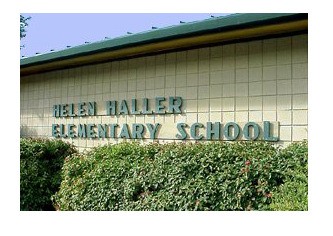Picture this — the City of Sequim and surrounds in 1980. Long strings of traffic roll through Washington Street on the way to Hurricane Ridge. Some people stop at local restaurants. Cows graze on pasture lands and vegetables grow in the large green valley.
About 52,000 people lived in all of Clallam County, most clustered in and around Port Angeles. Sequim was a distant second, a yet undiscovered gem of retirement living and big box stores.
Helen Haller Elementary School, the only elementary school in the Sequim School District, was 4 years old and the first learning home for 503 girls and boys.
The school was named for Helen Haller who taught and was a principal at Sequim Schools during the 1930s and 1940s.
She was pictured as a student in a 1908 photo long before she became the wife of Walter Haller. You may be familiar with the Haller name well known in our community for sustained charitable giving through the Albert Haller Foundation. He was her brother-in-law.
Helen must have been proud to have her name attached to the new, sparkling elementary school.
Ah, those were the sweet bucolic days of Sequim fondly remembered by many residents. But the secret spilled out and retirees discovered the moderate temperatures and low rainfall of the Blue Hole.
Businesses began arriving and more people with them. Service industries and house construction brought jobs for younger people who either came in or stayed. The population of Clallam County increased by over 40 percent by 2014, much of it in greater Sequim.
Helen Haller plays musical portables
The demand for elementary school capacity began to outgrow Helen Haller in less than a decade. The 1980s saw the addition of six portables brought in to house the learning needs of children and three more to house children for special education when the state and community accommodated the right of all children to participate in public education. Helen Haller was bursting under the pressure of 840 students until Greywolf Elementary was built and opened in Carlsborg in 1992. Helen Haller moved out of five portables and functioned with the remaining four until 2014 and 2015 when three portables were added.
Greywolf remained portable-free until 2014 when two portables were added to accommodate full-day kindergarten.
Hopefully termed temporary portables became hopelessly permanent after decades of use to stretch capacity.
It’s simple
Musical portables, the increasing number of students and acceleration of the requirements of elementary school education have worn poor Helen Haller out. She can’t do it anymore. It’s that simple.
The school district’s elementary school population has grown 121 percent since 1976. Greywolf has seen a 13-percent increase since its opening in 1992.
Perhaps more important, the demands on school districts have dramatically increased.
An early example is the mandate to integrate disabled children into the schools to give them opportunity. It’s called special education and requires facilities; however, the goal of integration is remote given they are located in portables.
In fact, all students are isolated. Helen Haller occupying more space than screens or display boards. Anyone with facility security experience will have nightmares tonight after reading this.
The district meets the minimum legal requirement for accommodating handicaps but there are no doors with the option to push a plate to open the door. If a student or staff can’t push or pull a door with their body, they can’t get in or out.
School districts have been charged with providing breakfast and lunch to students for several years now and do so despite using outdated kitchen equipment and facilities.
Space or lack of rules
Working around inadequate space and facilities limits our elementary schools’ ability to meet standards. Functions become servants to the available space without regard for what the standard is.
All-day kindergarten is now a requirement which means more kids using more space. Helen Haller already runs shifts for lunch — 6 or 7 — which means students get only 15 minutes for lunch which includes waiting in line. The recommendation is to allow 20 minutes.
Greywolf provides 50 minutes of PE a week instead of the 100 minutes of PE a week as required by Washington Administrative code because the multipurpose room is used for food service, physical education and assemblies. All-day kindergarten added 100 meals a day and more time in the one large room.
Imagine the time it takes to orchestrate hundreds of children having lunch and PE.
So what’s the problem?
The problem is that 69 percent of the school bond is going to building a new elementary school that will replace poor Helen Haller, something I believe she would applaud, and add two classrooms and one gym to Greywolf. It’s a big target, never mind one is on its last legs and the other is on course to repeat history, just 26 more entry points to go.
Helen Haller will be repurposed to serve Alternative Learning Experiences such as Olympic Academy, the program that allows a combination of home school and public education. They currently are in a building that uses curtains instead of doors and is scheduled for demolition in favor of a storage facility.
Could it be that some voters really don’t understand the seriousness of the need?
Or just like the feel of a good taxation protest?
Or could it be that the makers of portables don’t want to lose the business?
Be informed and vote. It’s elementary.
Bertha D. Cooper is retired from a 40-plus year career as a health care administrator focusing on the delivery system as a whole. She still does occasional consulting. She is a featured columnist at the Sequim Gazette. Reach her at columnists@sequimgazette.



